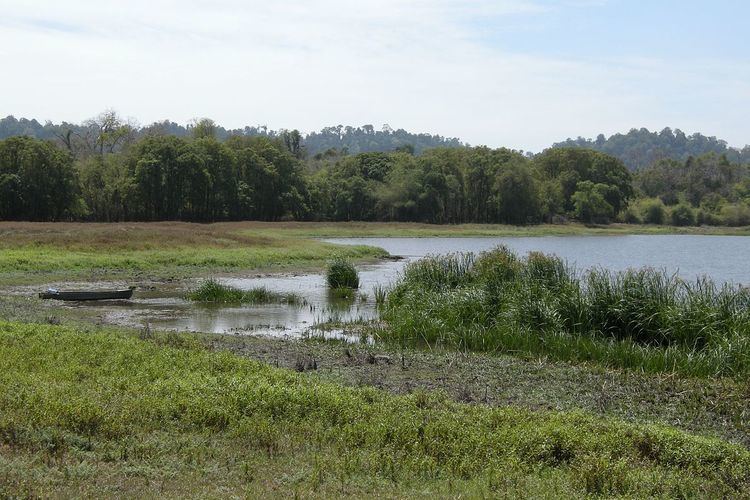Location Việt Nam Area 720 km (280 sq mi) | Nearest city Tan Phu Established 1992 (present extent) | |
 | ||
Governing body Ministry of Agriculture and Rural Development (MARD) | ||
Cát Tiên National Park (Vietnamese: Vườn quốc gia Cát Tiên) is a national park located in the south of Vietnam, approximately 150 km north of Ho Chi Minh City. It has an area of about 720 km2 and protects one of the largest areas of lowland tropical forests left in Vietnam.
Contents
History
Cát Tiên national park was protected initially in 1978 as two sectors, Nam Cat Tien and Tay Cat Tien. Another sector, Cat Loc, was gazetted as a rhinoceros reserve in 1992 upon the discovery of a population of the Vietnamese Javan rhinoceros, an occasion that brought the park into the world's eye. The three areas were combined to form one park in 1998. Nam Cat Tien is contiguous with Vĩnh Cửu nature reserve thus providing an enlarged area for species to breed.
The park suffered historically during the Vietnam War when it was extensively sprayed with defoliant herbicides. However, substantial further damage was done by logging up until the 1990s. To this day these areas have extensive bamboo and grassland cover and trees have not yet grown back.
Archaeology
The Cát Tiên archaeological site is located just outside the park boundary on the northern bank of the Dong Nai river (between Cat Loc and Nam Cat Tien, facing in to the latter). Excavations carried out between 1994 and 2003 revealed a group of temples, belonging to a previously unknown Hindu civilization which probably inhabited the area between the 4th century and 9th centuries AD (possibly later). A large number of a number of gold, bronze, ceramic, coloured stone, and glass artefacts, are currently displayed in the Da Lat museum.
Biodiversity
Cát Tiên National Park consists of seasonal tropical forests, grasslands and riparian areas. The forests are dominated by Dipterocarpaceae, Fabaceae and Lythraceae. Of the latter, Lagerstroemia spp. are common, especially L. calyculata and there are also spectacularly large specimen trees of Tetrameles nudiflora (Tetramelaceae). 40% of the park comprises bamboo woodland, with Bambusa balcooa, B. blumeana and B. procera; the remaining 10% consists of and grassland (often disused farmland) and wetlands: which include swamps and isolated wet meadows in un-drained patches of forest.
Mammals
The park hosts many mammal species; the following may be encountered:
Primates include the endemic golden-cheeked gibbon Nomascus gabriellae
Carnivores:
Bats (confirmed records):
Rodents and Lagomorphs - the Park list includes:
Other notable mammal species that are vulnerable or endangered include:
Besides the gaur, recently confirmed even-toed ungulate records include:
The park fauna included the Javan rhinoceros, and was one of only two populations in the world, until poachers shot and killed the last rhino in Cát Loc in 2010. There are also records of banteng and kouprey, but these may now be globally extinct, and wild Asian water buffalo no longer occur in Cat Tien. Some accounts also list Indochinese tigers, leopards, clouded leopards and dholes; however, a recent series of surveys did not confirm this.
Birds
The park has an impressive list of bird species including:
Reptiles
The reptile list includes the following notable species:
Agamid lizards
Snakes - 43 species recorded including:
Invertebrates
The most developed insect lists currently cover ants, butterflies, dragonflies, mosquitoes and termites; of the latter, Macrotermes spp. have an important ecological role, with large colony mounds very commonly encountered in the forest.
In 2007, the velvet-worm Eoperipatus totoro was discovered in the Crocodile Lake area by scientists of the Vietnam-Russia Tropical Centre.
Threats
Cat Tien comprises an important reserve in Vietnam, both for the habitat it protects and the number of species it contains. Although the population of the Javan rhinoceros went into extinction, it is still home to 40 IUCN Red List species, and protects around 30% of Vietnam's species. The park is, however, threatened by encroachment from local communities, illegal logging and poaching. In addition, the park is too small for the larger species found inside it. This has led to either their local extinction or conflict with local people as these animals move beyond the confines of the park. This problem is particularly intense for the park's elephant population, which is prone to wandering and is considered too small to be self sustainable.
Since the early 1990s, partly as a result of the discovery of rhinos in the park, international donors and the Vietnamese government began to invest more money in protecting the park and managing the resources of local State Forest Enterprises, nearby and adjoining forests (including Vinh Cuu Nature Reserve), in co-ordination with the park as a whole. There have been moves to combine a management plan that allows for both traditional park management and some limited resource utilisation by local people, which include the Stieng, Chau Ma (now concentrated in Ta Lai) and Cho'ro minorities.
In 2008 the Forestry Protection Department collaborating with the Endangered Asian Species Trust (UK), Monkey World Ape Rescue(UK) and Pingtung Wildlife Rescue Centre (Taiwan) founded the Dao Tien Endangered Primate Species Centre. The centre focusses on the rescue, rehabilitation and release of the four endangered primates found in Cat Tien (golden-cheeked gibbon, black-shanked douc, pygmy loris and silvered langur), developing Government guidelines for release of primates. The centre conducts informative daily educational tours explaining the centre's work, with a chance to see young rehabilitated gibbons in the trees.
